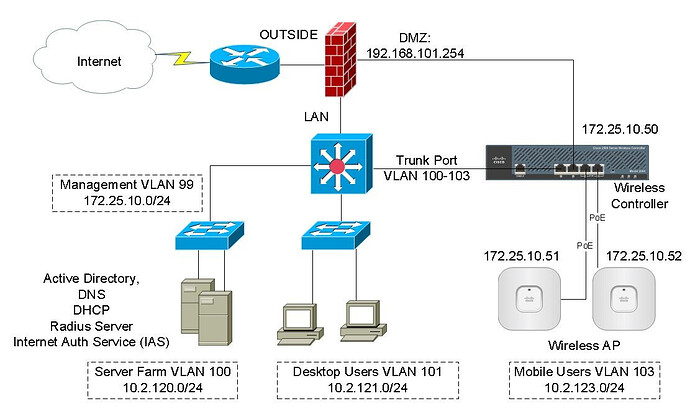Cisco WLC (Wireless LAN Controller) is a device or software platform used to manage wireless access points (APs) within an enterprise or large network. It provides centralized control and management for the wireless network infrastructure, allowing network administrators to configure, monitor, and secure wireless networks more efficiently.
How Cisco WLC Works
-
Centralized Management: Cisco WLC enables centralized management of multiple wireless access points. Instead of configuring each AP individually, the WLC provides a single interface to configure settings like SSID (Service Set Identifier), security policies, and roaming capabilities.
-
Configuration and Monitoring: Through the WLC, administrators can set up and manage network policies, monitor network traffic, and view performance metrics such as signal strength, data rates, and client associations.
-
Seamless Roaming: When a wireless client moves from one access point to another within the network, the WLC ensures seamless roaming by managing the handoff process, so there is no disruption to the client’s connection.
Primary Uses of Cisco WLC
-
Centralized Wireless Network Management: Simplified Deployment: The WLC allows network administrators to deploy and configure multiple access points from a centralized location, eliminating the need for individual configurations on each access point.
-
Security and Policy Enforcement: Access Control Cisco WLC supports different security protocols like WPA2/WPA3, 802.1X (for RADIUS authentication), and WPA-PSK, allowing secure access control to the network.
-
Wireless Performance Optimization Load Balancing: The WLC can balance the client load across multiple access points to ensure optimal performance and avoid overloading any one AP.
-
Seamless Roaming for Clients Efficient Handover: When users move between access points (for example, from one building to another), the WLC ensures seamless roaming by managing the handoff process without interrupting the client’s connection.
-
Monitoring and Troubleshooting Real-time Monitoring: It provides real-time monitoring of wireless network performance, allowing administrators to track metrics such as signal strength, client connections, and throughput.
-
Network Scalability Supports Large Networks: Cisco WLC supports large-scale wireless networks, such as those found in large campuses, offices, universities, and stadiums, by managing hundreds or thousands of access points.
-
High Availability and Redundancy Redundant Controllers: Cisco WLC can be deployed in pairs to provide high availability. If one controller fails, the other can take over, ensuring minimal downtime for the wireless network.
Benefits of Using Cisco WLC
-
Simplified Network Management
-
Improved Network Performance
-
Enhanced Security
-
Scalability
LinkedIn: ![]()
